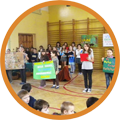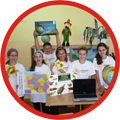The 50/50 methodology is a 9-step methodology aiming at the achievement of energy and financial savings in a building. It actively involves buildings’ users in the process of energy management and teaches them environmentally friendly behaviour through practical actions.
|
|
||||
|
||||
|
||||
|
||||
|
||||
|
||||
|
||||
|
||||
|
||||
|
||||
Below you may find short characteristics of the 9 steps that will lead you towards energy and financial savings:
STEP 1 – SETTING UP OF THE ENERGY TEAM
 The energy team should consist of a group of pupils (one class or representatives of different classes), one or two interested teachers and the school caretaker. Its task is to explore the current energy situation of the school and to propose and implement energy saving measures. The team will also organize an information & education campaign addressed to the rest of the school community.
The energy team should consist of a group of pupils (one class or representatives of different classes), one or two interested teachers and the school caretaker. Its task is to explore the current energy situation of the school and to propose and implement energy saving measures. The team will also organize an information & education campaign addressed to the rest of the school community.
STEP 2 – INSIDER ENERGY TOUR
 Before starting the work with the pupils, the director together with involved teachers and the school caretaker take part in a so called „Insider energy tour” which will prepare them for their future tasks. The aim of this tour is to:
Before starting the work with the pupils, the director together with involved teachers and the school caretaker take part in a so called „Insider energy tour” which will prepare them for their future tasks. The aim of this tour is to:
- make an initial assessment of the energy characteristics of the school building (including assessment of the heating system, technical state of the building, etc.);
- identify the elements, to which pupils’ attention should be drawn, as well as finding potential fields of success for the pupils.
STEP 3 – RAISING THE PUPILS’ KNOWLEDGE AND AWARENESS ON ENERGY ISSUES
 At this stage of project implementation pupils (both from the energy team and others) learn about issues as:
At this stage of project implementation pupils (both from the energy team and others) learn about issues as:
- forms of energy, using energy in everyday life and its impact on the environment,
- greenhouse effect, climate change and climate protection,
- energy saving, energy efficiency, use of renewable energy sources.
The issues can be raised both during regular classes and during additional meetings with pupils (i.e. meetings of school environmental clubs, meetings of the energy team). The aim is to raise the pupils’ knowledge and awareness of issues related to climate and energy, as well as to make them aware that there are opportunities to do something about climate change and that their individual actions do matter.
STEP 4 – ENERGY TOUR
 This time the energy tour is made by the energy team. Supported by the teachers and the school caretaker, the pupils inspect the whole school building and evaluate different aspects influencing the energy consumption in the school, including:
This time the energy tour is made by the energy team. Supported by the teachers and the school caretaker, the pupils inspect the whole school building and evaluate different aspects influencing the energy consumption in the school, including:
- technical state of the building
- heating system
- lighting
- use of electronic equipment
- use of water
All school rooms should be checked: class rooms, corridors, staircases, gyms, toilets, the teacher’s room, storage rooms, etc.
STEP 5 – LONG-TERM TEMPERATURE MEASUREMENTS AND ENERGY USE ASSESSMENT
 At this stage of project implementation the energy team has two tasks:
At this stage of project implementation the energy team has two tasks:
- Making a long-term temperature profile of the school by measuring temperatures in all school rooms for 2 weeks and checking if they correspond to the established standards.
- Assessment of energy use based on:
- observing how other pupils, teachers and other school building users’ behaviour influences the energy consumption in the school. They pay special attention to such behaviour as: methods of airing the rooms, methods of regulating the heating, the use of electrical and electronic equipment, etc.
- making surveys among other pupils (outside the energy team) regarding their opinion about temperatures and air quality in the school, habits concerning the use of electrical and electronic equipment and other energy-related issues.
STEP 6 – PROPOSING SOLUTIONS
 At this stage the energy team discusses its findings and develops propositions for solutions, the implementation of which will reduce energy consumption at the school (change of behaviour and small investments). The team also identifies „target groups” of the proposals, as well as ways to approach them with the energy-saving message.
At this stage the energy team discusses its findings and develops propositions for solutions, the implementation of which will reduce energy consumption at the school (change of behaviour and small investments). The team also identifies „target groups” of the proposals, as well as ways to approach them with the energy-saving message.
STEP 7 – INFORMATION CAMPAIGN
 At this stage the energy team shares what they have learned during project implementation with the rest of the school, as well as their proposals what all energy users in school can do to save energy. The team may use different communication channels, including: making posters and bulletin board displays, making presentations during class time and at school events, organization of an Energy Saving Day, creating a dedicated website, etc.
At this stage the energy team shares what they have learned during project implementation with the rest of the school, as well as their proposals what all energy users in school can do to save energy. The team may use different communication channels, including: making posters and bulletin board displays, making presentations during class time and at school events, organization of an Energy Saving Day, creating a dedicated website, etc.
STEP 8 – REPORTING MEASURES WHICH REQUIRE SMALL INVESTMENTS
 Sometimes even small amounts of money can make a big change! Although the main aim of the 50/50 methodology are non-investment energy savings (by change of users’ behaviour), the energy team can also propose the implementation of small investments and turn to school authority and/or other potential sponsors, asking them for support.
Sometimes even small amounts of money can make a big change! Although the main aim of the 50/50 methodology are non-investment energy savings (by change of users’ behaviour), the energy team can also propose the implementation of small investments and turn to school authority and/or other potential sponsors, asking them for support.
STEP 9 – COMMUNICATING AND USING THE MONEY SAVED
 Involving the pupils in the decision on how to use the money saved is a very important part of the project. This way they will really feel that their actions have positive and measurable results. Therefore, after each year of 50/50 implementation it is necessary to calculate and inform the school society, how much energy, CO2 and money was saved, and then discuss with the pupils about what shall be done with the money saved.
Involving the pupils in the decision on how to use the money saved is a very important part of the project. This way they will really feel that their actions have positive and measurable results. Therefore, after each year of 50/50 implementation it is necessary to calculate and inform the school society, how much energy, CO2 and money was saved, and then discuss with the pupils about what shall be done with the money saved.
And remember, the project should be fun for the pupils and other building users!
How EURONET 50/50 MAX will support implementation of the 50/50 methodology?
EURONET 50/50 MAX will support the implementation of the 50/50 methodology at schools and other public buildings by:
- Providing the 50/50 e-pack including a set of methodological and educational material & tools.
- Organising trainings for local authorities, schools and non-school public buildings involved in the project.
- Creating teamworks between “experienced” and “learning” schools.
- Running the 50/50 network aiming to boost relationships and exchange of experiences and ideas between schools and other buildings applying the 50/50 concept.
















 The sole responsibility for the content of this website lies with the authors. It does not necessarily reflect the opinion of the European Union. Neither the EACI nor the European Commission are responsible for any use that may be made of the information contained therein.
The sole responsibility for the content of this website lies with the authors. It does not necessarily reflect the opinion of the European Union. Neither the EACI nor the European Commission are responsible for any use that may be made of the information contained therein.